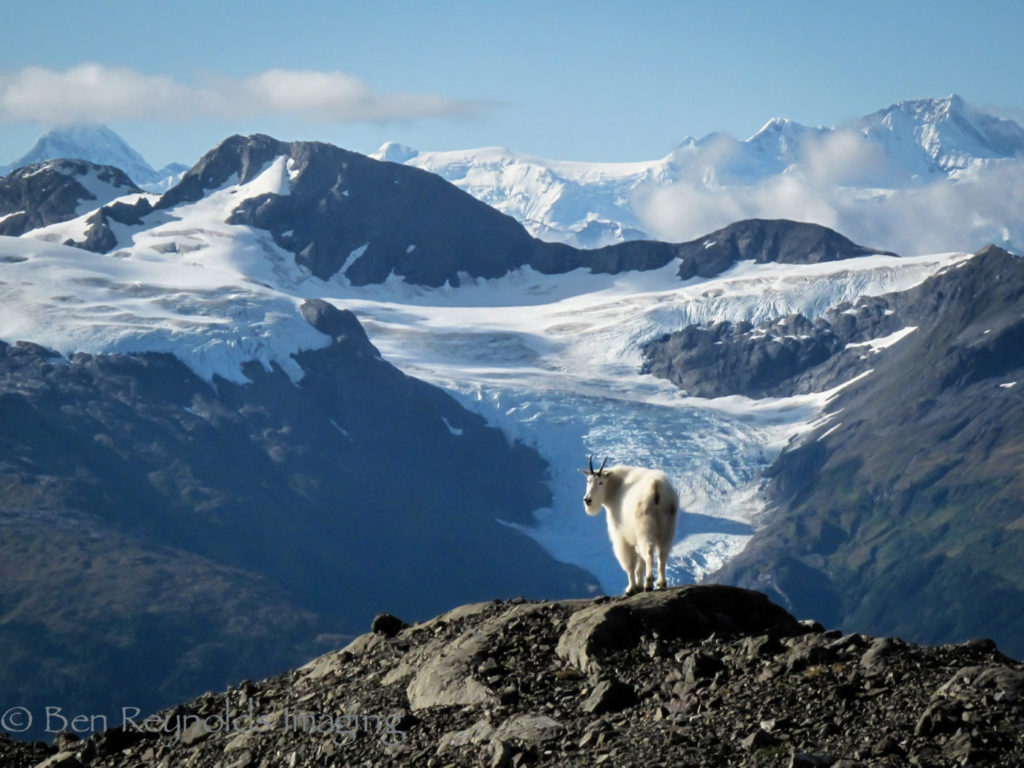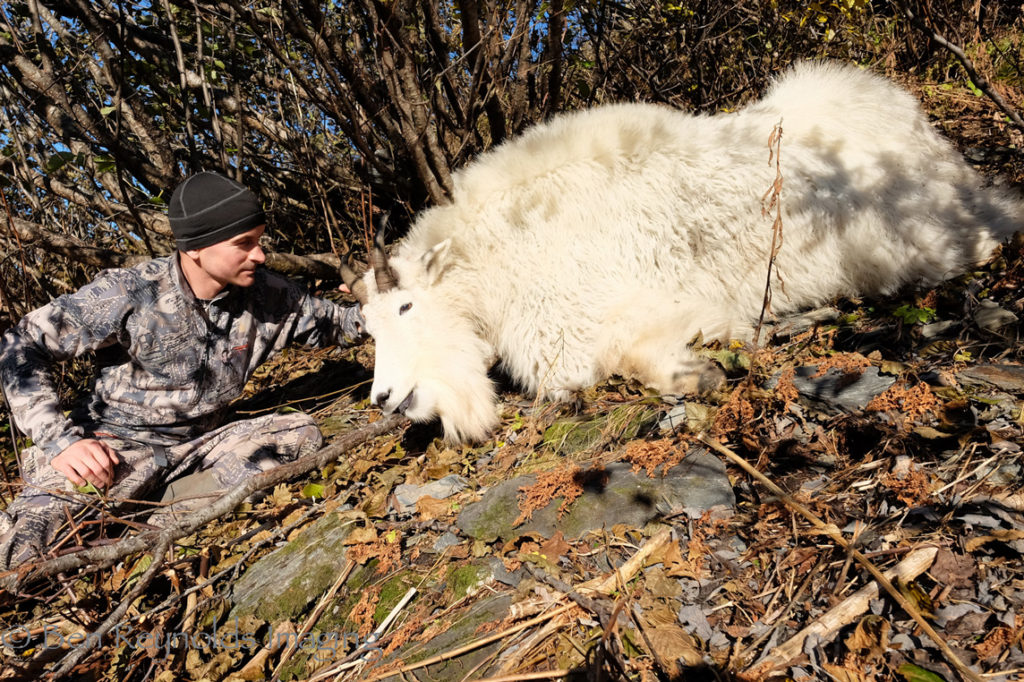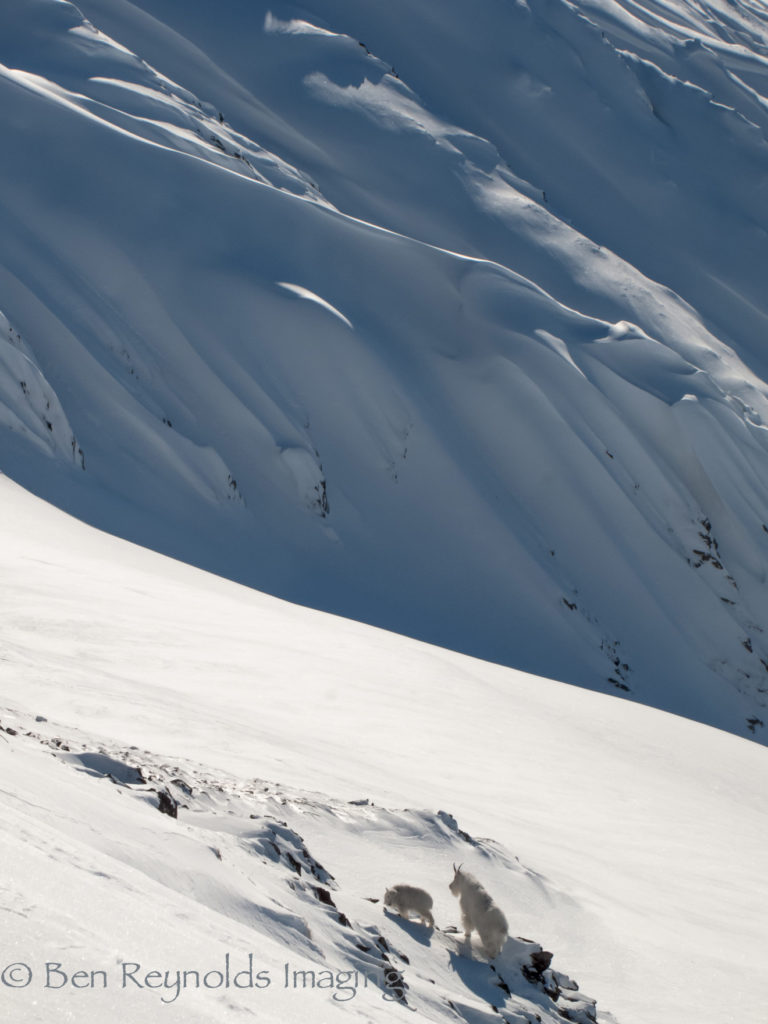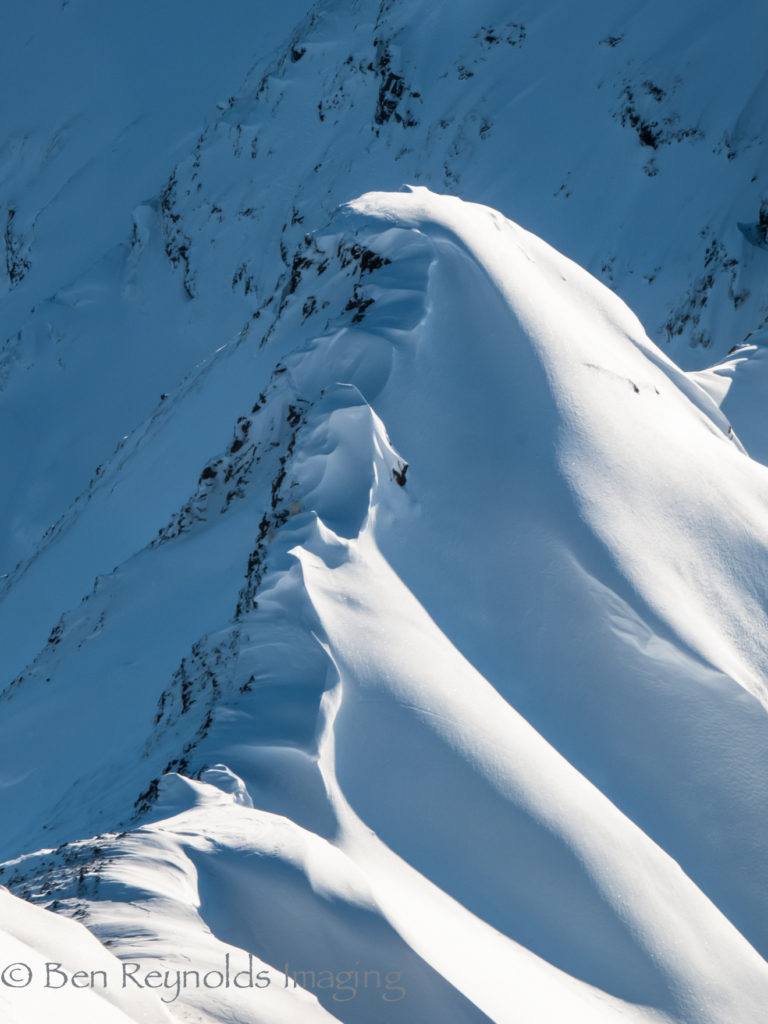
Hunters in pursuit of game are not seeking out the same slopes and terrain that the skier is, but due to the habitat that goats and sheep occupy, hunters often must pass through or under terrain that could potentially put them at risk. This risk is not always apparent. In this article, we will not have our heads down in a snow pit examining the micro instabilities of the snow layers. We will, however, examine the mountain environment and how to make a proper risk analysis when hunting mountain game in the late season.

The risks associated with hunting goats in winter take many forms. First, there are the subjective hazards. These are human-caused risks. These hazards can be controlled or minimized through proper experience, skill, and training. Dehydration, overexertion, and climbing into an area that is above your skill level are examples of such.
Objective hazards, on the other hand, are those you do not have control over. Your abilities have nothing to do with these events. Rockslides, lightning strikes, and avalanches all fall under this category. What you can do, however, is recognize factors that will contribute to an objective hazard incident and take action to minimize your exposure.
Mountain goats are without peer when it comes to the severe terrain they call home. While summer finds them on the highest peaks, in the colder months they travel to their wintering grounds. Snowpack plays a large role in where they will winter. Interior ranges that receive less snow than the coastal regions will often have bare, windswept ridge lines where goats can find lichen and travel more easily. In the coastal mountains, where the snow accumulates by the meter, the wintering grounds will typically be lower in elevation, to escape the deep snow and harsh weather. The elevation, on average, may be lower, but make no mistake; goats still find their refuge among high-angle terrain and cliff faces. There may be little snow, but it is what lies thousands of feet above that can prove to be the danger.
Mountain Snowpack
To understand the formation and triggers of avalanches, it is necessary to have a basic understanding of the mountain snowpack. The snowpack is made up of layers of snow, which are created as snow falls throughout the winter season. These layers and the bonds between them can change over time due to the influence of weather and further precipitation. This is the basis for the formation of avalanches. Nature provides us with five warning signs of high avalanche risk. The mountain hunter should be on the lookout for the presence of one or more of these signs. The more flags that are present, the higher the risk of an avalanche.
These five red flags are as follows:
- Recent avalanche activity
- Rapid temperature rise
- Significant snowfall in the last 24 hours
- Shooting cracks (or “whoompfing”) in the snowpack
- Strong winds
The first step to making wise decisions starts before you even lace up your boots. When you have decided on an area to hunt, take the time to study topographic maps and Google Earth. With these tools, you will be able to evaluate whether there are large alpine slopes above where you will be hunting, as well as deep gullies that can funnel slides down to lower elevations.
Abrupt weather pattern changes play a critical part in the level of avalanche danger. Before you head out, watch the weather patterns leading up to your hunt. Large storms that deposit large amounts of snow, rapid warming trends, and high winds all play a role in increasing slope instability. For Canadians, study the avalanche advisories on www.avalanche.ca in the nearest area to where you will be venturing out. Alaskans can check out the Chugach National Forest Avalanche Information Center (www.cnfaic.com). Even if the hunt is outside of the closest advisory area, you may be able to extrapolate some of the information and use it to help guide your decisions.
With these pre-hunt tasks completed, once in the field, focus on the basic rules of avalanche risk assessment. Now is the time to use your powers of observation to identify more red flags:
Slide paths and recent avalanche activity:
Sometimes these are obvious. There may be old avalanche debris in a deep ravine or fanned out onto a slope below a large face. At other times, you may be in thick timber where it is more difficult to view the upper mountain. Here you may find large areas of alders in an otherwise forested area. These are caused by previous slides taking out the larger trees, leaving alders as the only tree to have taken root again. It is best to minimize the time spent in these areas.
Rapid temperature rise:
Whenever there is a rapid and dramatic increase in temperature, avalanche danger rises. Bonds between layers can weaken and make slopes more susceptible to sliding. Solar radiation can also cause wet slides later in the winter. Roller balls or “cinnamon rolls” on south-facing slopes later in the winter are a common sign that the snowpack is under more stress. Mountain goats will often be found on these southern slopes in the winter.
Shooting cracks:
When on wind loaded slopes, you may observe shooting cracks in the snow. This is a sign that the snow is cohesive and contains potential energy. If this is over a weak layer on a slope, the danger is very real that a slide could be triggered. “Whoompfing,” or settling of the snow, can also indicate cohesiveness of a wind slab over a weak layer.
Active wind loading:
Plumes of snow coming off ridge tops can be a clue that there is active wind loading taking place. This snow can form hard wind slabs on leeward slopes. The added weight from these slabs can be the trigger the slope needs to induce a slide on a weak bed surface.
Travel Protocol and Gear
These observations can now be integrated into your hunt plan. Both your ascent and descent should be planned in a manner that minimizes your time in higher risk terrain. Each individual hunter needs to evaluate their own risk tolerance if an animal presents itself in terrain that is potentially under a snow slope where one or more red flags have been observed. Mountain hunting is not safe, and risks are standard for when pursuing game in high places; however, it is wise to communicate with your partner well and make decisions that both can live with and accept the risks associated. If a decision is made to travel across a suspect slope or under a slide path, strict protocol should be followed.

Certain pieces of gear are key to winter mountain hunting:
- Ice axe (or Black Diamond Whippet–a trekking pole with a mini ice axe on the head)
- Crampons or micro spikes
- Lightweight rope
The axe and crampons can enable you to travel efficiently and safely over steep terrain. Moving fast in the mountains equates to safety as you travel across avalanche terrain. Having a rope with you has many advantages and can be life-saving in the event you are cliffed out on a descent and/or need to lower a heavy pack.
Mountain hunting already calls for extreme skill sets, knowledge, planning, and execution. If a late season hunt is part of your agenda, then please consider avalanche assessment an important piece of the puzzle.
Ben Reynolds
Mountain Hunter
AMPLID Snowboards Alaskan Ambassador



